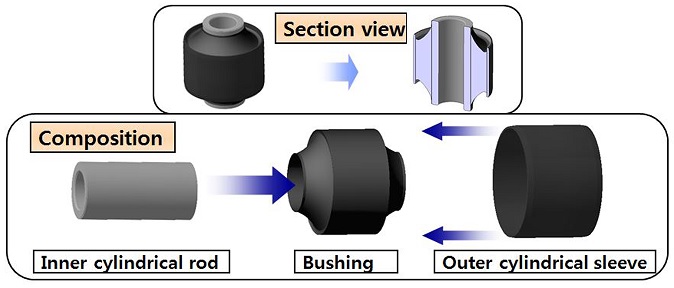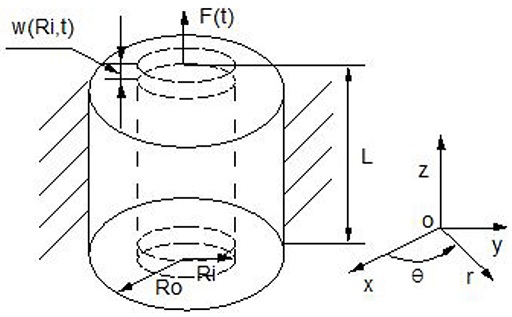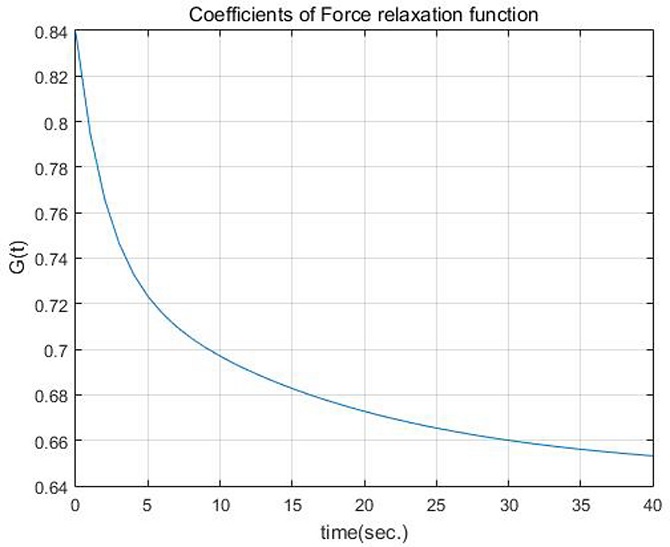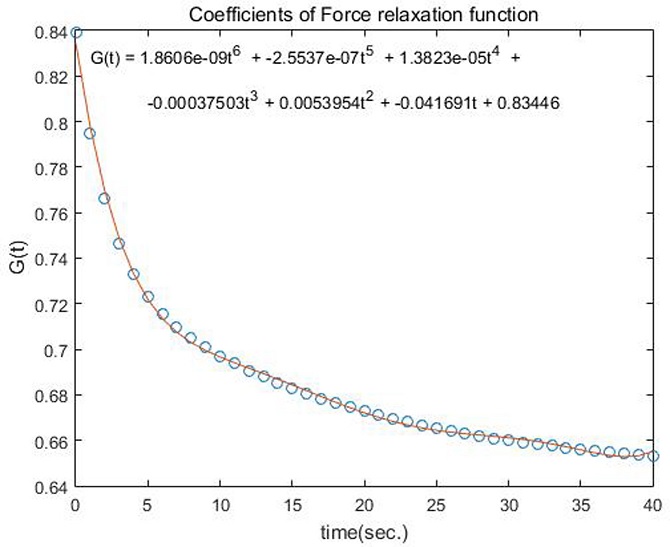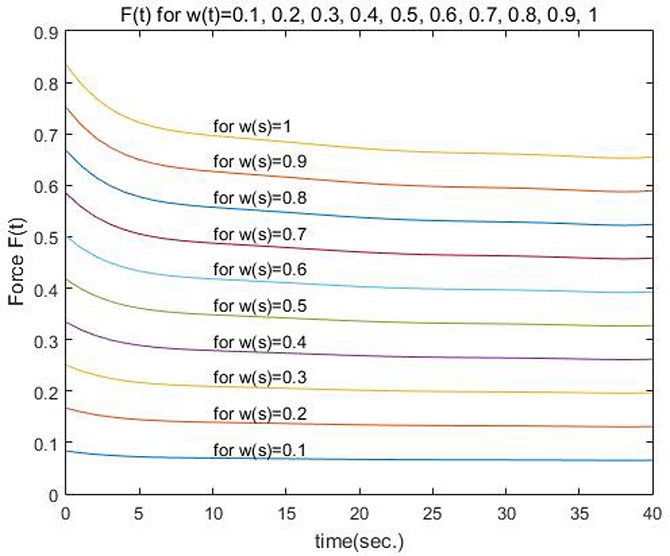
일래스토메릭 부싱의 축방향 모드에 대한 Modified Pipkin-Rogers 모델링
Copyright © The Korean Society for Precision Engineering
This is an Open-Access article distributed under the terms of the Creative Commons Attribution Non-Commercial License (http://creativecommons.org/licenses/by-nc/3.0) which permits unrestricted non-commercial use, distribution, and reproduction in any medium, provided the original work is properly cited.
Abstract
Elastomeric bushings are structural elements used in automotive suspension systems. A bushing is a hollow cylinder between an outer steel cylindrical sleeve and an inner steel cylindrical rod. The steel sleeve is connected to components of the suspension system and transfers forces from wheel to chassis. Force-Displacement relation for elastomeric bushings is critical for multi-body dynamics simulations. A boundary value issue for bushing response leads to force-displacement relation that requires extensive computation time to implement and therefore is unsuitable. Explicit force-displacement relation may be used in multi-body dynamics simulations. The relation is expressed in terms of a force relaxation function. Lianis model, Modified Lianis model, and Pipkin-Rogers model are introduced. Modified Pipkin-Rogers model was proposed and a boundary value issue was formulated for axial mode bushing response. Numerical solutions of the boundary value issue of Modified Pipkin-Rogers model were compared with results of the Pipkin-Rogers model. It is revealed that the method for determining bushing relaxation function and prediction of proposed force-displacement relation is in agreement with the original results.
Keywords:
Bushing, Lianis model, Pipkin-Rogers model, Viscoelasticity키워드:
부싱, 리아니스 모델, 핍킨-라저스 모델, 점탄성학1. 서론
자동차는 안정성이라는 가장 중요한 고려사항 외에도 탑승자의 승차감이 매우 민감한 요소로 주목 받아 왔다. 이러한 승차감과 관련된 부품으로는 현가장치(Suspension System)가 있으며, 현가장치는 차축과 차체를 연결하여 차체의 중량을 지지하고, 노면에서 전달되는 진동이나 충격이 차체에 직접 전달되지 않도록 하여 차체의 손상을 방지하고 승차감을 좋게 하는 역할을 한다. 또한, 자동차의 현가장치에서 일래스토메릭 부싱을 통하여 전달되는 하중은 자동차의 부품들에 대한 피로수명 예측 및 동특성에 직접 관련되는 중요성으로 인하여 자동차의 일래스토메릭 부싱에 대한 연구가 꾸준하게 진행되어 왔다.
자동차 현가장치의 일래스토메릭 부싱(Elastomeric Bushing)은 현가장치의 주요 부품으로 여러 가지 형상을 가지고 있고, 전달되는 하중의 형태도 다양하다. 본 연구에서는 일래스토메릭 부싱의 가장 단순한 형상으로 바깥쪽의 실린더형 슬리브와 안쪽의 실린더형 축 사이에서 가운데가 비어있는 실린더의 형상을 고려한다.
Wineman1-3 등은 미국 미시간대학교 기계공학과의 자동차 구조 내구성 센터(Center for Automotive Structural Durability Simulation)에서 수행한 일차원 반경방향 변위제어 실험으로부터, 주어진 하중과 변위와의 관계가 비압축성, 점탄성 성질을 보임을 확인하였다.
점탄성에 대한 개념은 Boltzman4 으로부터 유래를 찾아볼 수 있으며, Adkins와 Gent5는 원통형 부싱에 대해 여러 가지 실험을 통하여 힘과 변위와의 관계를 발전시켰으나, 이 연구는 선형 탄성론에 입각한 것으로 비선형성과 점탄성 성질을 설명하기에는 어려움이 있었다. Coleman과 Noll6은 근사적 구성방정식을 완성하기 위하여 페이딩 메모리 개념(Fading Memory Concept)을 이용하여, 등방성 점탄성고체에 대한 3차원 구성방정식을 완성하였다. McGuirt와 Lianis7는 스티렌-부타디엔 고무(Styrene-Butadiene Rubber)에 대한 실험을 통하여 비선형 점탄성 구성방정식을 완성하였고, 이 식은 Lianis Model로 명명되어 지금까지도 이용되고 있다. 또한, Morman8등 은 부싱을 비선형 점탄성고체로 모델링하였으며, 변형을 해석하기 위하여 유한요소법을 제안하였다.
이러한 점탄성학에 대한 이론은 Wineman과 Lee1에 의하여 자동차 현가장치의 일래스토메릭 부싱에 적용되었고, Lianis의 실험 데이터를 활용한 구성방정식을 이용하여 핍킨-라저스모델(Pipkin-Rogers Model) 이 완성되었으며, Lee9등은 이 핍킨-라저스모델을 반경방향 모드의 점탄성모델링에 적용하였다.
핍킨-라저스모델은 Lianis의 제안식에 기초를 둔 리아니스모델에 비하여 간단히 정리된 장점은 있으나 현장에서 편리하게 사용되기에는 여전히 복잡한 성질을 가지고 있으므로, 일래스토메릭 부싱에 대하여 더욱 편리하게 적용할 수 있는 새로운 모델이 필요로 하게 되었다. 본 연구에서는, 이러한 필요성에 따라, 일래스토메릭 부싱의 축방향모드에 대하여, 기존의 리아니스모델로부터 완성된 핍킨-라저스모델의 데이터를 활용하여 새로운 수정된 핍킨-라저스모델(Modified Pipkin-Rogers Model)을 제안하였으며, 이를 검증하여 향후에는 새로운 모델인 Modified Pipkin-Rogers Model이 사용될 수 있는 근거를 제시하였다.
2. Lianis Model 과 Pipkin-Rogers Model
2.1 Lianis Model
퍼듀대학교(Purdue University)의 Lianis7는 스티렌-부타디엔 고무에 대한 실험을 통하여, 응력과 변형률간의 구성방정식을 만들었고, Lianis가 실험을 통하여 제안한 기본식을 응력과 변형률의 관계로 나타내면 다음과 같다.
| (1) |
σ(t)는 응력텐서이며, p(t)는 비압축성의 제한으로부터 온 압력이며, t는 현재의 시간, s는 과거에서 현재까지의 시간, B는 왼쪽 코시-그린 텐서(Left Cauchy-Green Tensor), Ct(s)는 오른쪽 상대 코시-그린 텐서(Right Relative Cauchy-Green Tensor), I1과 I2는 B의 스트레인불변량(Strain Invariants)이고, I는 3 × 3 항등행렬(Identity Matrix)이며, 식(1)에 필요한 모드에 대하여 경계조건을 적용하여 원하는 리아니스모델을 완성할 수 있다.
또한, 실험값인 P0(t), Q0(t), P1(t), Q1(t)은 스티렌-부타디엔 고무의 0°C에서 시간에 따라 변하는 물질의 특성이며, a, b, c, d는 일정한 값을 갖는 물질의 특성으로, 실험적으로 구하여진 값들은 Table 1 에 나타내었다.
2.2 Pipkin-Rogers Model
미국 미시간대학교 기계공학과의 자동차 구조 내구성 센터(Center for Automotive Structural Durability Simulation)에서는 현가장치의 동역학적 현상을 정확히 예측하기 위하여 정확한 자동차 부싱의 모델이 필요하게 되었고, Lee와 Wineman1,10은 복잡한 Lianis Model을 대체할 수 있는 새로운 점탄성 모델로서, Pipkin과 Rogers가 제안한 형태의 식을 부분적분법으로 정리한 후 하중과 변형량에 대한 새로운 관계식을 정립하여 이를 Pipkin-Rogers Model로 명명하였고, 이 관계를 축방향 모드에 대하여 제안한 기본식은 다음과 같다.
| (2) |
F(t)는 현재 시간 t에서의 힘을 나타내며, w(s)는 시간 s에서의 변위를 나타내고, R은 변위에 의존하는 힘완화함수(Displacement Dependent Force Relaxation Function)이다.
2.3 외삽법(Extrapolation Method)
일반적인 모의실험에서는 컴퓨터를 이용하기 때문에 스텝변위 제어실험(Step Displacement Control Test)이 가능하지만, 실제의 실험을 수행함에 있어서는 스텝변위(Step Displacement)를 만들수가 없으므로, Ramp-to-Constant Displacement Control Test를 수행하여야 한다. 따라서, 본 연구에서도 기본 데이터를 얻는 과정에서 Ramp-to-Constant Displacement Control Test를 이용하였으며, 이에 대하여 Fig. 1에 나타내었다.
Fig. 1의 입력변위의 기울기는 에서 0으로 바뀌며, Ramp-to-Constant Displacement Control Test 의 결과인 힘은 Fig. 1의 Force Output에 나타나 있다. Fig. 1의 입력 변위는 j가 증가함에 따라 가 에 접근하는 것을 세 종류의 변위입력을 보여주고 있다. 또한, 구하여진 힘은 변위들 각 각에 대한 Ramp-to-Constant Displacement Control Test의 결과로 나온 힘이다. 의 값을 최대한 0에 가까운 값을 갖는 실험을 수행한 후에, 이 실험데이터를 바탕으로 이 되었을 때의 결과를 얻고자 하며, 이 결과로부터 스텝변위제어실험(Step Displacement Control Test)의 결과를 얻기 위하여는 외삽법(Extrapolation Method)의 사용이 반드시 필요하다. 외삽법은 다양한 램프함수의 결과를 스텝함수의 결과로 바꾸어 주는 것으로서 이에 대한 이론적 설명은 Lee1의 박사학위논문에 상세히 설명되어 있다.
3. 자동차 현가장치의 일래스토메릭 부싱
3.1 일래스토메릭 부싱의 형상
자동차 현가장치의 일래스토메릭 부싱은 다양한 형상을 가지고 있으나, 본 연구에서 고려한 형상은 가장 단순한 형태인 바깥쪽의 실린더형 슬리브와 안쪽의 실린더형 축 사이에서 가운데가 비어있는 실린더의 형태를 가지고 있으며, Fig. 2에 나타내었다.
3.2 축방향 모드에 대한 Modified Lianis Model
일래스토메릭 부싱은 가운데가 비어있는 실린더로 가정되어 축방향 대칭이며, 관성은 무시되었으며, 변형전과 변형후의 형상은 Fig. 3와 같다.
본 연구에서는, 바깥쪽 슬리브를 고정시키고, 가장 큰 변형이 발생하는 안쪽의 변위와 주어진 힘과의 관계를 가지는 축방향 모드를 고려하였으며, 경계조건으로 외부반지름에서의 축방향의 변위를 0으로 놓고, 내부반지름에서의 축방향 변위와 주어진 힘과의 관계를 구하였다. Lianis 가 제안한 식(1)을 축방향 모드에 대하여 정리하면 다음과 같다.
| (3) |
3.3 축방향 모드에 대한 Modified Pipkin-Rogers Model
Lee1는 주어진 하중 F(t)와 외부반지름에서의 축방향 변위 w(s)의 관계를 구하고자 하였으며, 시간 s < 0에서는 주어진 하중도 없으며, 변위도 발생하지 않는 것으로 가정하였으며, Lianis의 실험식에 기초한 Lianis Model을 이용하여, Ramp-to-Constant Displacement Control Test를 수행하여 모의실험데이터를 확보하였으며, 힘에 대한 외삽법(Force Extrapolation Method)과 최소자승법(Least Squares Method) 을 이용하여 변위에 의존하는 힘완화함수(Displacement Dependent Force Relaxation Function)를 구하여 소수점 넷째 자리까지 완성한 축방향 모드에 대한 핍킨-라저스모델은 다음과 같다.
| (4) |
식(4)로부터, w(s) =0.1부터 1.0에 대한 Step Displacement Control Test의 결과인 힘(Force)은 변위에 의존하는 힘완화함수(Displacement Dependent Force Relaxation Function)로서 R(w(s),t)로 나타내며, Fig. 4에 나타내었다.
힘완화함수(Force Relaxation Function) R(w(s),t)은 식(4)와 같이 내부반지름에서의 축방향 변위인 w(s)의 홀수의 거듭제곱들의 합의 형태로 식(5)와 같이 표현된다.
| (5) |
식(5)는 지금까지 널리 이용되어 왔으나, 고무물질에 대한 점탄성현상을 포함하는 종합적인 시뮬레이션이 복잡화되고 있는 현실에서는 보다 단순한 식의 필요성이 제기되고 있으므로, 본 연구에서는 힘완화함수(Force Relaxation Function) R(w(s),t)을 내부반지름에서의 축방향 변위인 w(s)와 현재시간 t의 함수인 G(t)와의 곱인 선형관계의 식을 이용한 수정된 핍킨-라저스모델(Modified Pipkin-Rogers Model)로 제안하며 다음과 같이 정리하였다.
| (6) |
식(6)은 구성된 식의 단순성으로 그 효용성이 증대될 수 있으며, 그동안 오차를 조절하지 못하여 제안되지 못하였으나, 컴퓨터와 수치해석의 발전으로 인하여 본 연구에서는 고무물질에 대한 오차범위 내에서 충분히 사용가능함이 증명되었다.
Figs. 5는 4의 데이터에 선형 최소자승법을 적용한 불연속 데이터 G(t)를 나타내고 있으며, 시간에 대한 불연속성을 표현하고자 본문에서는 G(ta)로 표기하였다.
시간 ta(a = 1, 2, 3, ..., 41)에 대한 G(ta)를 다음과 같이 다항식함수(Polynomial Function)로 정의하였다.
| (7) |
본 연구에서는 n = 6 을 사용한 6차다항식을 이용하였으며, 수정된 핍킨-라저스모델(Modified Pipkin-Rogers Model)에 필요한 힘완화함수 G(t)는 다음과 같다.
| (8) |
Fig. 5의 불연속데이터를 ‘o’로 표기하고, 식(8)의 결과를 실선으로 표기하여 Fig. 6에 나타내었다.
G(t)와 G(ta)를 비교하기 위하여, G(t)의 G(ta)의 에 대한 상대 오차를 2-Norm 개념을 도입하여 다음과 같이 정의하였다.
| (9) |
G(t)의 G(ta)에 대한 상대오차는 0.23% 이며, 점탄성 모델을 축방향모드에 대하여 완성한 Modified Pipkin-Rogers Model은 다음과 같다.
| (10) |
3.4 Pipkin-Rogers Model과 Modified Pipkin-Rogers Model의 결과 비교
Pipkin-Rogers Model과 Modified Pipkin-Rogers Model에 대하여, 주어진 동일한 변위로부터 구하여진 힘 F(t)의 결과를 비교하였다.
Fig. 4는 Pipkin-Rogers Model의 결과로 나온 힘 F(t)를 나타내고 있으며, Figs. 7은 4와 동일하게 주어진 Displacement Input에 대하여 Modified Pipkin-Rogers Model을 이용한 결과를 보여주고 있다.
두 모델의 결과인 F(t)를 비교하기 위하여, 식(9)와 같은 방법으로 상대오차를 놈(2-Norm)을 이용하여, 다음과 같이 정의하였다.
| (11) |
식(11)로부터, w(s) =0.1부터 1.0에 대하여, Modified Pipkin-Rogers Model 결과의 Pipkin-Rogers Model 결과에 대한 상대오차는 각각 7, 6.61, 5.97, 5.09, 4, 2.73, 1.32, 0.3, 1.71, 3.1% 로 제안한 점탄성 부싱모델이 부싱모델로서 사용가능함을 알 수 있다. w(s) = 0.1, 0.2, 0.3 등 주어진 변위의 값이 작은 경우에 상대오차가 큰 원인은 주어진 실험데이터의 범위가 넓어짐에 따른 것이라 할 수 있으며, 이는 데이터의 양을 보다 많이 획득함으로서 해결이 가능하며 고무부싱의 어려운 예측을 고려하여 볼 때 10% 미만의 오차는 여전히 유효하다고 할 수 있다.
4. 결론
본 연구에서는 축방향의 힘과 변위에 대한 관계를 알아보는데 있어서, 두 가지의 모델이 제안되었다. Lianis Model을 이용한 기존의 응용역학방법을 이용한 후, 결과로 나온 힘에 대한 외삽법(Extrapolation Method)을 활용한 Pipkin-Rogers Model은 Lianis Model 이 가지고 있는 관련식들이 음함수로 연결됨으로 인하여 동역학적 모의실험에 이용하기에 어려운 문제를 해결하였으나, 여전히 수식의 복잡성으로 인하여 현장에서 사용하기에는 어려움이 있었다.
따라서, 본 연구에서는 Ramp-to-Constant Displacement Control Test 를 이용하여 Modified Lianis Model을 활용하고 힘에 대한 외삽법을 이용한 Pipkin-Rogers Model로 부터의 결과와 새로이 제안된 Modified Pipkin-Rogers Model의 결과를 비교하여 오차범위 내에서의 좋은 결과를 얻었다.
본 연구의 목적은 축방향 모드에 대하여 현장에서 사용이 담보된 단순화된 점탄성 모델을 완성하는 것이며, Modified Pipkin-Rogers Model의 결과는 원하는 오차범위 내에서 사용이 가능함을 알 수 있었다. 이는 Modified Pipkin-Rogers Model이 기존의 Pipkin-Rogers Model 뿐만 아니라 10여년전까지 주로 사용되어온 Lianis Model을 대치할 수 있다는 것을 검증하고 있으므로, 부싱에 대한 새로운 점탄성모델로서 Modified Pipkin-Rogers Model을 사용할 수 있는 근거를 제시한다.
향후의 연구과제로는, 본 연구방법을 회전방향모드와 반경방향모드에 적용되어야 하고, 실제 부싱에 대한 실험결과를 토대로 한 연구도 고려되어야 할 것이다. 또한, 축방향모드, 반경방향모드, 회전방향모드의 복합모드에 대한 연구가 필요하다.
NOMENCLATURE
| s : | Time |
| t : | Current time |
| w : | Displacement |
| k : | Strain |
| T : | Rise time |
| σ(t) : | Stress at time t |
| F(t) : | Force at time t |
| G(t) : | Force relaxation function |
| R(w(s),t) : | Displacement dependent force relaxation function |
Acknowledgments
본 논문은 2016학년도 인제대학교 학술연구조성비 보조에 의한 것임.
REFERENCES
- Lee, S., “A Study of a Nonlinear Viscoelastic Model of Elastomeric Bushing Response,” Ph. D. Thesis, University of Michigan, pp. 1-190, 1997.
-
Wineman, A. S., Van Dyke, T., and Shi, S., “A Nonlinear Viscoelastic Model for One Dimensional Response of Elastomeric Bushings,” International Journal of Mechanical Sciences, Vol. 40, No. 12, pp. 1295-1305, 1998.
[https://doi.org/10.1016/S0020-7403(98)00023-X]

-
Lee, S. and Wineman, A., “A Model for Nonlinear Viscoelastic Torsional Response of an Elastomeric Bushing,” Acta Mechanica, Vol. 135, Nos. 3-4, pp. 199-218, 1999.
[https://doi.org/10.1007/BF01305752]

-
Boltzmann, L., “Zur Theorie der Elastischen Nachwirkung,” Annalen der Physik, Vol. 241, No. 11, pp. 430-432, 1878.
[https://doi.org/10.1002/andp.18782411107]

-
Adkins, J. E. and Gent, A. N., “Load-Deflection Relations of Rubber Bush Mountings,” British Journal of Applied Physics, Vol. 5, No. 10, p. 354, 1954.
[https://doi.org/10.1088/0508-3443/5/10/305]

-
Coleman, B. D. and Noll, W., “Foundations of Linear Viscoelasticity,” Reviews of Modern Physics, Vol. 33, No. 2, pp. 239-249, 1961.
[https://doi.org/10.1103/RevModPhys.33.239]

-
McGuirt, C. W. and Lianis, G., “Constitutive Equations for Viscoelastic Solids under Finite Uniaxial and Biaxial Deformations,” Transaction of the Society of Rheology, Vol. 14, No. 2, pp. 117-134, 1970.
[https://doi.org/10.1122/1.549182]

-
Morman, K. N., Kao, B. G., and Nagtegaal, J. C., “Finite Element Analysis of Viscoelastic Elastomeric Structures Vibrating About Nonlinear Statically Stressed Configurations,” SAE International Technical Papers, Paper No. 811309, 1981.
[https://doi.org/10.4271/811309]

- Lee, S, Choi, J., and Min, J., “A Study of a Nonlinear Viscoelastic Model for Elastomeric Bushing in Radial Mode,” Int. J. Precis. Eng. Manuf., Vol. 5, No. 2, pp. 16-21, 2004.
-
Pipkin, A. C. and Rogers, T. G., “A Non-Linear Integral Representation for Viscoelastic Behavior,” Journal of the Mechanics and Physics of Solids, Vol. 16, pp. 59-72, 1968.
[https://doi.org/10.1016/0022-5096(68)90016-1]



